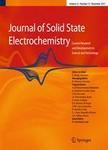版权所有:内蒙古大学图书馆 技术提供:维普资讯• 智图
内蒙古自治区呼和浩特市赛罕区大学西街235号 邮编: 010021

作者机构:Dongguk Univ Dept Energy & Mat Engn Res Ctr Photoenergy Harvesting & Convers Technol Seoul 04620 South Korea
出 版 物:《JOURNAL OF SOLID STATE ELECTROCHEMISTRY》 (固体电化学杂志)
年 卷 期:2019年第23卷第2期
页 面:503-512页
核心收录:
学科分类:081704[工学-应用化学] 07[理学] 070304[理学-物理化学(含∶化学物理)] 08[工学] 0817[工学-化学工程与技术] 0703[理学-化学]
基 金:Basic Science Research Program through the National Research Foundation of Korea (NRF) - Ministry of Education [NRF-2015M1A2A2054996, NRF-2016R1A2B2012061] Technology Development Program to Solve Climate Changes of the National Research Foundation (NRF) - Ministry of Science, ICT & Future Planning [NRF-2016M1A2A2940912] Dongguk University Research Fund of 2016
主 题:Copper nanoparticles Electrochemical sensor Hydrogenation reaction Glucose 4-Nitrophenol
摘 要:Thin film of metallic Cu nanoparticles was synthesized by a one-pot chemical reduction method at ambient temperature. Cu(II) acetate monohydrate and hydrazine monohydrate were used as precursor and reducing agent without additional surfactants to form uniform layer of Cu nanoparticle layer on a glass substrate (Cu/G). The XRD and the effectiveness of the electrocatalytic and catalytic properties of the Cu/G have been applied for an amperometric detection of glucose and for the chemical reduction of 4-nitrophenol. The former exhibited the detection limit as low as 2.47M with a linear range of 0.01-0.2mM, while the latter showed the efficient catalytic activity with a high rate constant of 0.503/min. The current method suggested in this work might be useful for the fabrication of glass-based Cu nanoparticles electrodes for industrial and biomedical applications.